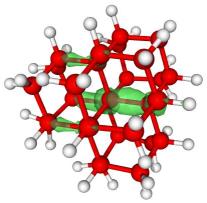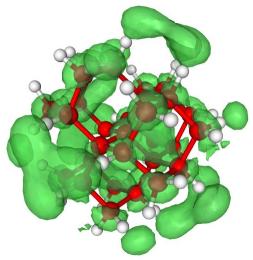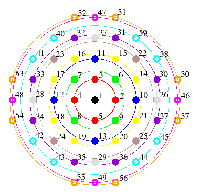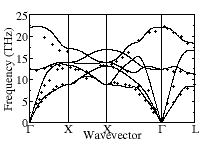- B. Thorpe, M. J. Smith, P. J. Hasnip and
N. D. Drummond, Acceleration of the CASINO quantum Monte Carlo
software using graphics processing units and OpenACC, submitted
to
Comput. Phys. Commun. (2025). [Preprint: arXiv:2507.02888]
- S. Azadi, N. D. Drummond, A. Principi, R. V. Belosludov and
M. S. Bahramy, Quantum Monte Carlo study of the quasiparticle
effective mass of the two-dimensional uniform electron liquid,
submitted to Phys. Rev. B (2025).
[Preprint: arXiv:2505.05879]
- F. Della Pia, B. Shi, Y. S. Al-Hamdani, D. Alfè,
T. Anderson, M. Barborini, A. Benali, M. Casula, N. D. Drummond,
M. Dubecký, C. Filippi, P. Kent, J. Krogel, P. López
Ríos, A. Lüchow, Y. Luo, A. Michaelides, L. Mitas,
K. Nakano, R. Needs, M. Per, A. Scemama, J. Schultze, R. Shinde,
E. Slootman, S. Sorella, A. Tkatchenko, M. Towler, C. Umrigar,
L. Wagner, W. A. Wheeler, H. Zhou and A. Zen, Is fixed-node
diffusion quantum Monte Carlo reproducible?, submitted to
J. Chem. Phys. (2025).
[Preprint: arXiv:2501.12950]
- M. Szyniszewski, E. Mostaani, A. Knothe, V. Enaldiev,
A. C. Ferrari, V. I. Fal'ko and N. D. Drummond, Adhesion and
reconstruction of graphene/hexagonal boron nitride heterostructures:
a quantum Monte Carlo study, ACS Nano 19, 6014 (2025).
[Download]
- S. Azadi, N. D. Drummond and S. M. Vinko, Quantum Monte Carlo
study of the phase diagram of the two-dimensional uniform electron
liquid, Phys. Rev. B 110, 245145
(2024). [Download]
- K. Morawetz, V. Ashokan, K. N. Pathak, N. Drummond and G.
Cuniberti, Electronic quantum wires in extended quasiparticle
picture, Phys. Rev. B 109, 205116
(2024). [Download]
- G. J. Bean, N. D. Drummond and J. Ruostekoski, Propagation of
light in cold emitter ensembles with quantum position correlations due
to static long-range dipolar interactions,
Phys. Rev. Research 6, 013078 (2024).
[Download]
- S. Azadi, N. D. Drummond and S. M. Vinko, Correlation energy
of the spin-polarized electron liquid studied using quantum Monte
Carlo simulations, Phys. Rev. B 108, 115134
(2023). [Download]
- E. Mostaani, R. J. Hunt, D. M. Thomas, M. Szyniszewski,
A. R. P. Montblanch, M. Barbone, M. Atatüre, N. D. Drummond and
A. C. Ferrari, Charge-carrier complexes in monolayer
semiconductors, Phys. Rev. B 108, 035420
(2023). [Download]
- K. A. Simula, J. Härkönen, I. Zhelezova,
N. D. Drummond, F. Tuomisto and I. Makkonen, Quantum Monte Carlo
study of Doppler broadening of positron annihilation radiation in
semiconductors and insulators, Phys. Rev. B 108, 045201
(2023). [Download]
- I. Amelio, N. D. Drummond, E. Demler, R. Schmidt and
A. Imamoglu, Polaron spectroscopy of a bilayer excitonic
insulator, Phys. Rev. B 107, 155303
(2023). [Download]
- A. Girdhar, V. Ashokan, R. O. Sharma, N. D. Drummond and
K. N. Pathak, Wire-width and electron-density dependence of the
crossover in the peak of the static structure factor from
2kF→4kF in
one-dimensional paramagnetic electron gases,
Phys. Rev. B 107, 115414
(2023). [Download]
- S. Azadi, N. D. Drummond and S. M. Vinko, Correlation energy
of the paramagnetic electron gas at the thermodynamic limit,
Phys. Rev. B 107, L121105
(2023). [Download]
- G. Cassella, H. Sutterud, S. Azadi, N. D. Drummond, D. Pfau,
J. S. Spencer and W. M. C. Foulkes, Discovering quantum phase
transitions with fermionic neural networks,
Phys. Rev. Lett. 130, 036401
(2023). [Download]
- F. Marsusi, E. Mostaani and N. D. Drummond, Quantum Monte
Carlo study of three-dimensional Coulomb complexes: trions and
biexcitons; hydrogen molecules and ions; helium hydride cations; and
positronic and muonic complexes, Phys. Rev. A 106, 062822
(2022). [Download]
- K. A. Simula, J. E. Muff, I. Makkonen and
N. D. Drummond, Quantum Monte Carlo study of positron lifetimes in
solids, Phys. Rev. Lett. 129, 166403
(2022). [Download]
- S. Azadi and N. D. Drummond, Low-density phase diagram of the
three-dimensional electron gas, Phys. Rev. B 105, 245135
(2022). [Download]
- D. M. Thomas, Y. Asiri and N. D. Drummond, Point defect
formation energies in graphene from diffusion quantum Monte Carlo and
density functional theory, Phys. Rev. B 105, 184114
(2022). [Download]
- A. Girdhar, V. Ashokan, N. D. Drummond, K. Morawetz and
K. N. Pathak, Electron correlation and confinement effects in
quasi-one-dimensional quantum wires at high density, Phys. Rev. B
105, 115140
(2022). [Download]
- S. Azadi, N. D. Drummond and W. M. C. Foulkes, Quasiparticle
effective mass of the three-dimensional Fermi liquid by quantum Monte
Carlo, Phys. Rev. Lett. 127, 086401
(2021). [Download]
- R. O. Sharma, N. D. Drummond, V. Ashokan, K. N. Pathak and
K. Morawetz, Ground-state properties of electron-electron biwire
systems, Phys. Rev. B 104, 035149 (2021).
[Download]
- S. Slizovskiy, A. Garcia-Ruiz, A. I. Berdyugin, X. Na,
T. Taniguchi, K. Watanabe, A. Geim, N. D. Drummond and V. I.
Fal'ko, Out-of-plane dielectric susceptibility of graphene in
twistronic and Bernal bilayers, Nano Lett. 21, 6678 (2021).
[Download]
- S. J. Magorrian, V. Zólyomi and
N. D. Drummond, Structures of bulk hexagonal post transition metal
chalcogenides from dispersion-corrected density functional theory,
Phys. Rev. B 103, 094118 (2021).
[Download]
- R. J. Hunt, B. Monserrat, V. Zólyomi and
N. D. Drummond, Diffusion quantum Monte Carlo and GW study of the
electronic properties of monolayer and bulk hexagonal boron
nitride, Phys. Rev. B 101, 205115
(2020). [Download]
- R. J. Needs, M. D. Towler, N. D. Drummond, P. López
Ríos and J. R. Trail, Variational and diffusion quantum
Monte Carlo calculations with the CASINO code,
J. Chem. Phys. 152, 154106 (2020).
[Download]
- F. Vialla, M. Danovich, D. A. Ruiz-Tijerina, M. Massicotte,
P. Schmidt, T. Taniguchi, K. Watanabe, R. J. Hunt, M. Szyniszewski,
N. D. Drummond, T. G. Pedersen, V. I. Fal'ko and
F. H. L. Koppens, Tuning of impurity-bound interlayer complexes in
a van der Waals heterobilayer, 2D Mater. 6, 035032 (2019).
[Download]
- J. Li, N. D. Drummond, P. Schuck and V. Olevano, Comparing
many-body approaches against the real helium atom exact solution,
SciPost Phys. 6, 040
(2019). [Download]
- D. M. Thomas, R. J. Hunt, N. D. Drummond and M. Hayne, Binding
energies of excitonic complexes in type-II quantum rings from
diffusion quantum Monte Carlo calculations,
Phys. Rev. B 99, 115306 (2019).
[Download]
- F. Marsusi, N. D. Drummond and M. J. Verstraete,
The physics of single-side fluorination of graphene: DFT and
DFT+U studies, Carbon 144, 615 (2019).
[Download]
- V. Ashokan, N. D. Drummond and K. N. Pathak, One-dimensional
electron fluid at high density, Phys. Rev. B 98, 125139
(2018). [Download]
- R. J. Hunt, M. Szyniszewski, G. I. Prayogo, R. Maezono and
N. D. Drummond, Quantum Monte Carlo calculations of energy gaps
from first principles, Phys. Rev. B 98, 075122
(2018). [Download]
- B. Monserrat, N. D. Drummond, P. Dalladay-Simpson, R. T. Howie,
P. López Ríos, E. Gregoryanz, C. J. Pickard and
R. J. Needs, Structure and metallicity of phase V of hydrogen,
Phys. Rev. Lett. 120, 255701
(2018). [Download]
- M. Danovich, D. A. Ruiz-Tijerina, R. J. Hunt, M. Szyniszewski,
N. D. Drummond and V. I. Fal'ko, Localized interlayer complexes in
heterobilayer transition metal dichalcogenides,
Phys. Rev. B 97, 195452
(2018). [Download]
- O. Witham, R. J. Hunt and N. D. Drummond, Stability of trions
in coupled quantum wells modeled by two-dimensional bilayers,
Phys. Rev. B 97, 075424
(2018). [Download]
- E. Mostaani, M. Szyniszewski, C. H. Price, R. Maezono, M.
Danovich, R. J. Hunt, N. D. Drummond and V. I. Fal'ko, Diffusion
quantum Monte Carlo study of excitonic complexes in two-dimensional
transition-metal dichalcogenides, Phys. Rev. B 96, 075431
(2017). [Download]
- M. Szyniszewski, E. Mostaani, N. D. Drummond and
V. I. Fal'ko, Binding energies of trions and biexcitons in
two-dimensional semiconductors from diffusion quantum Monte Carlo
calculations, Phys. Rev. B 95, 081301(R)
(2017). [Download]
- S. Azadi, N. D. Drummond and W. M. C. Foulkes, Nature of the
metallization transition in solid hydrogen,
Phys. Rev. B 95, 035142 (2017).
[Download]
- N. D. Drummond, J. R. Trail and R. J. Needs, Trail-Needs
pseudopotentials in quantum Monte Carlo calculations with
plane-wave/blip basis sets, Phys. Rev. B 94, 165170
(2016). [Download]
- M. Danovich, I. L. Aleiner, N. D. Drummond and
V. I. Fal'ko, Fast relaxation of photo-excited carriers in 2-D
transition metal dichalcogenides, IEEE J. Sel. Top. Quantum
Electron. 23, 6000105
(2016). [Download]
- G. G. Spink, P. López Ríos, N. D. Drummond and
R. J. Needs, Trion formation in a two-dimensional hole-doped
electron gas, Phys. Rev. B 94, 041410(R)
(2016). [Download]
- E. Mostaani, B. Monserrat, N. D. Drummond and C. J. Lambert,
Quasiparticle and excitonic gaps of one-dimensional carbon
chains, Phys. Chem. Chem. Phys. 18, 14810
(2016). [Download]
- F. Liu, S. Zheng, A. Chaturvedi, V. Zólyomi, J. Zhou,
Q. Fu, C. Zhu, P. Yu, Q. Zeng, N. D. Drummond, H. J. Fan, C. Kloc,
V. I. Fal'ko, X. He and Z. Liu, Optoelectronic properties of
atomically thin ReSSe with weak interlayer coupling,
Nanoscale 8, 5826
(2016). [Download]
- E. Mostaani, N. D. Drummond and V. I. Fal'ko, Quantum Monte
Carlo calculation of the binding energy of bilayer graphene,
Phys. Rev. Lett. 115, 115501
(2015). [Download]
- N. D. Drummond, B. Monserrat, J. H. Lloyd-Williams,
P. López Ríos, C. J. Pickard and R. J. Needs, Quantum
Monte Carlo study of the phase diagram of solid molecular hydrogen at
extreme pressures, Nat. Commun. 6, 7794
(2015). [Download]
- A. Kormányos, G. Burkard, M. Gmitra, J. Fabian,
V. Zólyomi, N. D. Drummond and
V. I. Fal'ko, k.p theory for two-dimensional
transition metal dichalcogenide semiconductors, 2D
Mater. 2, 022001 (2015).
[Download]
- B. Ganchev, N. D. Drummond, I. Aleiner and
V. Fal'ko, Three-particle complexes in two-dimensional
semiconductors, Phys. Rev. Lett. 114, 107401
(2015). [Download]
- W. W. Tipton, N. D. Drummond and R. G. Hennig, Importance of
high-angular-momentum channels in pseudopotentials for quantum Monte
Carlo, Phys. Rev. B 90, 125110 (2014).
[Download]
- V. Zólyomi, N. D. Drummond and V. I. Fal'ko, Electrons
and phonons in single layers of hexagonal indium chalcogenides
from ab initio calculations, Phys. Rev. B 89,
205416 (2014).
[Download]
- A. Kormányos, V. Zólyomi, N. D. Drummond and
G. Burkard, Spin–orbit coupling, quantum dots and qubits in
transition metal dichalcogenides, Phys. Rev. X 4, 011034
(2014).
[Download]
- F. Liu, H. Shimotani, H. Shang, T. Kanagasekaran,
V. Zólyomi, N. D. Drummond, V. I. Fal'ko and
K. Tanigaki, High-sensitivity photodetectors based on multilayer
GaTe flakes, ACS Nano 8, 752
(2014). [Download]
- B. Monserrat, N. D. Drummond, C. J. Pickard and
R. J. Needs, Electron–phonon coupling and the metalization
of solid helium at terapascal pressures,
Phys. Rev. Lett. 112, 055504 (2014).
[Download]
- A. J. Misquitta, R. Maezono, N. D. Drummond, A. J. Stone and
R. J. Needs, Anomalous nonadditive dispersion interactions in
systems of three one-dimensional wires, Phys. Rev. B 89,
045140 (2014).
[Download]
- G. G. Spink, R. J. Needs, and N. D. Drummond, Quantum Monte
Carlo study of the three-dimensional spin-polarized homogeneous
electron gas, Phys. Rev. B 88, 085121 (2013).
[Download]
- N. D. Drummond and R. J. Needs, Quantum Monte Carlo
calculation of the Fermi liquid parameters of the two-dimensional
homogeneous electron gas, Phys. Rev. B 88, 035133
(2013). [Download]
- A. Kormányos, V. Zólyomi, N. D. Drummond,
P. Rakyta, G. Burkard and V. I. Fal'ko, Monolayer
MoS2: trigonal warping, "Γ-valley" and
spin–orbit coupling effects, Phys. Rev. B 88,
045416 (2013).
[Download]
- V. Zólyomi, N. D. Drummond and V. I. Fal'ko, Band
structure and optical transitions in atomic layers of hexagonal
gallium chalcogenides, Phys. Rev. B 87, 195403
(2013). [Download]
- B. Monserrat, N. D. Drummond and R. J. Needs, Anharmonic
vibrational properties in periodic systems: energy,
electron–phonon coupling, and stress,
Phys. Rev. B 87, 144302
(2013). [Download]
- N. D. Drummond and R. J. Needs, Diffusion quantum Monte Carlo
calculation of the quasiparticle effective mass of the two-dimensional
homogeneous electron gas, Phys. Rev. B 87, 045131
(2013). [Download]
- P. López Ríos, P. Seth, N. D. Drummond and
R. J. Needs, Framework for constructing generic Jastrow correlation
factors, Phys. Rev. E 86, 036703 (2012).
[Download]
- N. D. Drummond, V. Zólyomi and
V. I. Fal'ko, Electrically tunable band gap in silicene,
Phys. Rev. B 85, 075423 (2012).
[Download]
- F. Marsusi, J. Sabbaghzadeh and N. D. Drummond, Comparison of
quantum Monte Carlo with time-dependent and static
density-functional theory calculations of diamondoid excitation
energies and Stokes shifts, Phys. Rev. B 84, 245315
(2011). [Download]
- N. D. Drummond, P. López Ríos, C. J. Pickard and
R. J. Needs, Quantum Monte Carlo study of a positron in an
electron gas, Phys. Rev. Lett. 107, 207402
(2011). [Download]
- R. M. Lee, G. J. Conduit, N. Nemec, P. López Ríos
and N. D. Drummond, Strategies for improving the efficiency of
quantum Monte Carlo calculations, Phys. Rev. E 83, 066706
(2011). [Download]
- R. M. Lee and N. D. Drummond, Ground-state properties of the
one-dimensional electron liquid, Phys. Rev. B 83, 245114
(2011). [Download]
- N. D. Drummond, N. R. Cooper, R. J. Needs and
G. V. Shlyapnikov, Quantum Monte Carlo calculation of the
zero-temperature phase diagram of the two-component fermionic
hard-core gas in two dimensions, Phys. Rev. B 83, 195429
(2011). [Download]
- R. Maezono, N. D. Drummond, A. Ma and R. J. Needs, Diamond to
β-tin phase transition in Si within diffusion quantum Monte
Carlo, Phys. Rev. B 82, 184108
(2010). [Download]
- S. J. Binnie, S. J. Nolan, N. D. Drummond, D. Alfè,
N. L. Allan, F. R. Manby and M. J. Gillan, Bulk and surface
energetics of crystalline lithium hydride: Benchmarks from quantum
Monte Carlo and quantum chemistry, Phys. Rev. B 82,
165431
(2010). [Download]
- Y. Kita, M. Tachikawa, N. D. Drummond and R. J. Needs, A
variational Monte Carlo study of positronic compounds using
inhomogeneous backflow transformations, Chem.
Lett. 39, 1136
(2010). [Download]
- N. D. Drummond, P. López Ríos, C. J. Pickard and
R. J. Needs, First-principles method for impurities in quantum
fluids: Positron in an electron gas, Phys. Rev. B 82,
035107
(2010). [Download]
- R. J. Needs, M. D. Towler, N. D. Drummond and P. López
Ríos, Continuum variational and diffusion quantum Monte
Carlo calculations, J. Phys.: Condens. Matter 22, 023201
(2010).
[Download]
- N. D. Drummond and R. J. Needs, Quantum Monte Carlo
calculation of the energy band and quasiparticle effective mass
of the two-dimensional Fermi fluid, Phys. Rev. B 80,
245104 (2009).
[Download]
- C.-R. Hsing, C.-M. Wei, N. D. Drummond and R. J. Needs,
Quantum Monte Carlo studies of covalent and metallic clusters:
accuracy of density functional approximations, Phys. Rev. B
79, 245401
(2009). [Download]
- N. D. Drummond and R. J. Needs,
Phase diagram of the low-density two-dimensional homogeneous
electron gas, Phys. Rev. Lett. 102, 126402
(2009). [Download]
- R. M. Lee, N. D. Drummond and R. J. Needs,
Exciton–exciton interaction and biexciton formation in
bilayer systems, Phys. Rev. B 79, 125308
(2009). [Download]
- N. D. Drummond and R. J. Needs, Quantum Monte Carlo study of
the ground state of the two-dimensional Fermi fluid, Phys. Rev. B
79, 085414
(2009). [Download]
- N. D. Drummond, R. J. Needs, A. Sorouri and W. M. C. Foulkes,
Finite-size errors in continuum quantum Monte Carlo
calculations, Phys. Rev. B 78, 125106
(2008). [Download]
- N. D. Drummond and R. J. Needs, van der Waals interactions
between thin metallic wires and layers,
Phys. Rev. Lett. 99, 166401
(2007). [Download]
- N. D. Drummond, Nanomaterials: Diamondoids display their
potential, Nat. Nanotechnol. 2, 462 (2007).
[Download]
- P. López Ríos, A. Ma, N. D. Drummond, M. D. Towler
and R. J. Needs, Inhomogeneous backflow transformations in quantum
Monte Carlo, Phys. Rev. E 74, 066701
(2006). [Download]
- N. D. Drummond, P. López Ríos, A. Ma, J. R. Trail,
G. G. Spink, M. D. Towler and R. J. Needs, Quantum Monte Carlo
study of the Ne atom and the Ne+ ion,
J. Chem. Phys. 124, 224104
(2006). [Download]
- N. D. Drummond and R. J. Needs, Quantum Monte Carlo, density
functional theory, and pair potential studies of solid neon,
Phys. Rev. B 73, 024107
(2006). [Download]
- I. G. Gurtubay, N. D. Drummond, M. D. Towler and R. J. Needs,
Quantum Monte Carlo calculations of the dissociation energies of
three-electron hemibonded radical cationic dimers,
J. Chem. Phys. 124, 024318
(2006). [Download]
- N. D. Drummond, A. J. Williamson, R. J. Needs and G. Galli,
Electron emission from diamondoids: a diffusion quantum Monte
Carlo study, Phys. Rev. Lett. 95, 096801
(2005). [Download]
- N. D. Drummond and R. J. Needs, Variance-minimization scheme
for optimizing Jastrow factors, Phys. Rev. B 72, 085124
(2005). [Download]
- A. Ma, M. D. Towler, N. D. Drummond and R. J. Needs, Scheme
for adding electron–nucleus cusps to Gaussian orbitals,
J. Chem. Phys. 122, 224322
(2005). [Download]
- A. Ma, M. D. Towler, N. D. Drummond and R. J. Needs,
All-electron quantum Monte Carlo calculations for the noble gas
atoms He to Xe, Phys. Rev. E 71, 066704
(2005). [Download]
- M. Y. J. Tan, N. D. Drummond and R. J. Needs, Exciton and
biexciton energies in bilayer systems, Phys. Rev. B 71,
033303
(2005). [Download]
- N. D. Drummond, M. D. Towler and R. J. Needs, Jastrow
correlation factor for atoms, molecules, and solids, Phys. Rev. B
70, 235119
(2004). [Download]
- S.-N. Luo, D. C. Swift, R. N. Mulford, N. D. Drummond and
G. J. Ackland, Performance of an ab initio equation of state
for MgO, J. Phys.: Condens. Matter 16, 5435
(2004). [Download]
- B. Wood, W. M. C. Foulkes, M. D. Towler and N. D. Drummond,
Coulomb finite-size effects in quasi-two-dimensional systems,
J. Phys.: Condens. Matter 16, 891
(2004). [Download]
- N. D. Drummond, Z. Radnai, J. R. Trail, M. D. Towler and
R. J. Needs, Diffusion quantum Monte Carlo study of
three-dimensional Wigner crystals, Phys. Rev. B
69, 085116
(2004). [Download]
- N. D. Drummond and G. J. Ackland, Ab initio quasiharmonic
equations of state for dynamically-stabilized soft-mode materials,
Phys. Rev. B 65, 184104
(2002). [Download]
Return to top
|




